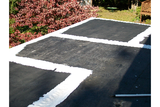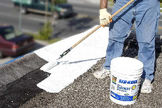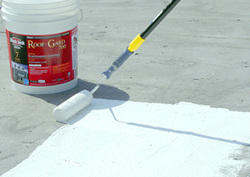How to Reduce your Cooling costs by painting your Roof white
Reduce your Cooling costs by painting your Roof white. Light colors reflect heat back through the atmosphere. Dark colors absorb heat. Compare this to wearing light or dark colored clothes out in the summer sun. Heat built up in an attic or crawlspace is often forced down through the walls and ceiling making cooling a difficult and expensive task. In the summer, that heat can easily range from 120º F to 150º F or more in our Southern States.
Steven Chu, a Nobel Prize winner sworn in as Secretary of Energy during the Obama administration, has made claims that painting roofs white could dramatically reduce the amount of energy needed to keep buildings comfortable while also helping to reduce Global Warming. The problem being, heat gets trapped in densely populated areas full of asphalt and commercial buildings. Referred to as 'heat Islands.' Chicago and some cities in California have made white roofs mandatory on all new construction.
Before we get started here, let me preface this tutorial by saying that this procedure works best when performed on a flat or shed pitched roof. This type of construction, commonly found in urban areas, are typically covered with rolled Asphalt, Tar or EPDM rubber membrane. Elastomeric coatings also work well when applied over sheet metal, concrete, and Modified Bitumen. While you can apply Elastomeric coating on a steep-pitched shingle roof, it could void the shingle warranty and create a slipping hazard for future roof repairs and maintenance. You should opt to have the roof reshingled in white or another light color.
Steven Chu, a Nobel Prize winner sworn in as Secretary of Energy during the Obama administration, has made claims that painting roofs white could dramatically reduce the amount of energy needed to keep buildings comfortable while also helping to reduce Global Warming. The problem being, heat gets trapped in densely populated areas full of asphalt and commercial buildings. Referred to as 'heat Islands.' Chicago and some cities in California have made white roofs mandatory on all new construction.
Before we get started here, let me preface this tutorial by saying that this procedure works best when performed on a flat or shed pitched roof. This type of construction, commonly found in urban areas, are typically covered with rolled Asphalt, Tar or EPDM rubber membrane. Elastomeric coatings also work well when applied over sheet metal, concrete, and Modified Bitumen. While you can apply Elastomeric coating on a steep-pitched shingle roof, it could void the shingle warranty and create a slipping hazard for future roof repairs and maintenance. You should opt to have the roof reshingled in white or another light color.
|
Things You'll Need:
* 5 Gal. Buckets of White Elastomeric Paint * Black Jack White Acrylic Roof Patch * Universal Reinforcement Fabric * 3/4" nap Rollers * Soft Roof Brush |
|
|
1. Clean the existing roof of all dirt, oil, grease, gravel and loose debris as a first step. If you find lichen or moss growing on the roof, it will need to be killed and removed as well. Preferably, clean the surface with a pressure washer. Allow the roof to dry thoroughly, before application. This alone may take an entire day in good weather.
 Roof Seams and Edges
2. Patch any cracks, seams and blisters using products such as Gardner-Gibson's Black Jack White Acrylic Roof Patch and Universal Reinforcement Fabric. To do this properly, you fill in any voids as you apply the patching compound. Cut and apply the reinforcing mesh and cover that with another application of compound. Allow this to cure, before top coating with any other products.
 White Elastomeric Roof Coating
3. Pay particular attention to possible leak points by applying a coat of white elastomeric paint to any seams and edges, as a precursor. You will coat them again as you apply the first and second coats of sealant to the rest of the roof.
4. Apply a primer on common flat or shed pitched roofs, especially ones that tend to hold rainwater. To do this, you must first complete the previous two steps in preparation. Kool Seal recommends applying two coats of primer. Apply in a north/south direction, then in an east west direction to assure complete coverage. The first coat of primer must dry before you apply a second coat. Typical drying time normally takes between 4 and 6 hours, depending on temperature and humidity. You must top-coat the primer an with Elastomeric coating.
5. Apply the top coat the same way as you applied the primer coat; with two coats, north/south, east/west. Allow each coat of paint to dry thoroughly before applying the next. Coverage is typically 50-75 square feet per gallon. You will get a little more coverage on metal/non-porous roofs. Be sure that you do not apply your paint too thinly. Tips * Be sure that the roof has good solid underlayment and framing, before replacing or adding any roofing material or coating. If the roof flexes, any materials applied may also flex, crack or separate. * Do you have a hot tin roof? Paint it white! * Aluminized Elastomeric coating is also a very good reflective choice! * Ideally, the Elastomeric coating should be applied while the roof temperature is between 65ºF & 95ºF. Stop and resume later, if the surface reaches 100ºF or higher. Warnings * Do not use 100% Silicone to seal seams. Paint will not adhere to it. Use [paintable] Latex, instead. * White or light colored roofs will save money on cooling homes and buildings in hot climates. But, they won't help very much in cooler climates. Copyright 05/28/2009 All Rights Reserved. Questions? Comments? Contact Me Images courtesy of Gardner-Gibson and APOC |
|
